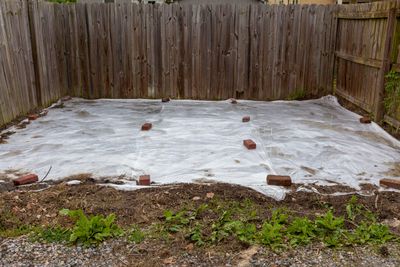Soil Temperature Gardening
Soil temperature gardening involves the placement of thin, clear plastic over the soil, with its edges buried within an outer trench. Large rolls of plastic can be obtained at most home and garden centers. Plastic uses the sun’s heat to raise soil temperatures. In fact, when properly done, the soil can reach temperatures up to 120 F. (49 C.) or more. These high temperatures easily wipe out many soil-borne diseases and other garden pests in the soil. It is important, however, that only clear plastic be used to solarize garden areas. Clear plastic allows sunlight to pass through more easily, which is vital for soil heat retention. Black plastic does not sufficiently heat the soil. Thin plastic (about 1-2 mil.) also yields better results, as sunlight is able to penetrate the plastic more easily. Solarization is most effective during the hot summer months when the soil receives the maximum amount of sunlight, as this will kill weed seeds and soil pathogens deep down in the soil. Unfortunately, this is also the time when most people are using their garden to grow plants, so summer solarization is only practical if you have a large garden and are able to sacrifice a portion of your space every year. That said, it can also be effective to solarize for four to six weeks in the spring prior to planting and in the fall after harvest.
How to Solarize Garden Beds
To solarize garden beds, the garden area should be level and free from any debris. Generally, the area is tilled and raked smooth before placing any plastic. For better soil heat retention, the soil should be moist but not saturated. Moisture helps heat penetrate the ground easier. Most soil problems are also more susceptible to solarization when the ground is moist. Before laying any plastic, a trench should to be incorporated around the outer edges of the garden. The depth can be anywhere from 8 to 12 inches (20 to 30 cm.) and about a foot (30 cm.) wide in order to secure the plastic in place. Once the trench has been dug out and the garden area raked smooth, the plastic is ready to be placed. Cover the entire garden area with the plastic, placing the edges into the trench and backfilling with the excavated soil. Be sure to keep the plastic pulled tight as you go. The closer the plastic fits against the soil, the fewer air pockets will be present, allowing the soil to retain more heat. Once you have finished laying the plastic, it should be left in place for about four to six weeks. Solarization enables soil heat retention, which in effect, not only helps eliminate most soil problems but also stimulates the release of nutrients presently found within the soil. Soil temperature gardening, or solarization, is one of the most effective methods of controlling garden pests in the soil and other related soil problems.
